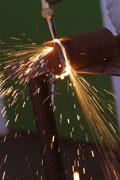Preparing ethyne and testing its properties
Ethyne is produced on an industrial scale from calcium carbonate (limestone) and coal:
CaO + 3C → CaC2 + CO
Calcium carbide and water are then reacted to produce ethyne and calcium hydroxide:
CaC2 + 2H2O → Ca(OH)2 + C2H2
Ethyne can also be manufactured by the partial combustion of methane with oxygen, or by the cracking of hydrocarbons.

In this demonstration, I prepare ethyne and do a series of simple tests on the gas to reveal some of its properties.
Microscale version
You can find a microscale version of this experiment that students can carry out as a class practical here.
Kit
- retort stand
- bowl
- pipette
- side-arm tube with bung
- rubber tubing and delivery tube
- six test tubes with bungs
- 0.002 M acidified potassium manganate(VII) solution, approximately 1 cm3
- 0.002 M bromine solution, approximately 1 cm3
- solid calcium carbide, CaC2 (IRRITANT, HIGHLY FLAMMABLE)
Procedure
Clamp the side-arm tube vertically and add two or three pieces of calcium carbide. Replace the bung. Connect the delivery tube to the side-arm with the rubber tubing, making sure the end of the delivery tube is under water in an adjacent bowl. Put six test tubes in the bowl and allow them to fill with water. Remove the bung of the side-arm tube and add two or three drops of water. Replace the bung and collect six test tubes of ethyne gas by downward displacement of water. As the gas leaves the delivery tube in the water carefully ignite the ethyne bubbles as they reach the air. A loud bang and a smoky flame are produced.
Test for ethyne by adding a bromine solution, or an acidic solution of potassium manganate(VII). In each experiment only a few drops of the test solution are needed. In the case of the bromine solution, the orange colour eventually disappears when ethyne is added. With manganate(VII), the acidified solution goes colourless but sometimes goes through a brown phase. The acidified oxidation of ethyne to ethan-1-2-dioic acid (oxalic acid) is the Baeyer's test for unsaturated organic compounds.
Safety
- Do not scale up. CLEAPSS members should consult HC019C.
- Calcium carbide will burn the skin, and is harmful if swallowed or inhaled. Solid CaC2 reacts with moisture in the air to produce gas, so pressure may build up in sealed containers containing the solid. Open containers with care.
- Ethyne forms explosive mixtures with air. Only ignite the gas bubbles once they have reached the surface of the water. Do not ignite the gas as it emerges from the delivery tube – if the apparatus still contains some air as well as the gas, the mixture is more explosive and the apparatus could explode.
Special tips
Ethyne is highly flammable and only small quantities should be made. Even small amounts of ethyne/air mixtures can produce damaging explosions if the mix is close to stoichiometric. If the gas is made to pass through a small nozzle, then it gets ample air to burn completely.
Teaching goals
Approximately 80% of the ethyne produced annually in the US is used in the synthesis of myriad organic compounds. When burned in oxygen, ethyne produces a flame temperature of over 3300°C, releasing 11,800 J g-1, making it also useful for welding, cutting, soldering metals, and increasingly for hardening steel.
The acidic hydrogen attached to the carbon-carbon triple bond in ethyne can separate from the rest of the molecule as a hydrogen ion, with the electro-negative carbon retaining both electrons from the broken covalent bond. Ethyne can therefore bond with metals, which distinguishes it from alkenes. For example, passing ethyne gas through ammoniacal copper(I) chloride produces an immediate red precipitate of copper(I) carbide; when bubbled through ammoniacal silver nitrate a white precipitate of silver carbide is produced. You can see this demonstration in Incendiary silver.
Cu2Cl2 + C2H2→ Cu2C2 + 2HCl
2AgNO3 + C2H2→ Ag2C2 + 2HNO3
Sodium amide, NaNH2, dissolved in liquid ammonia, is a very strong base and though unreactive towards alkanes and alkenes, will remove a proton from ethyne to form a salt:
NaNH2 + C2H2→ HCC- Na+ + NH3
These salts will react with halogen-oalkanes, providing a useful route to synthesising carbon-carbon bonds:
CH3CC- Na+ + CH3CH2Br → CH3CH2CCCH3 + NaBr
Ethyne reacts with several reagents, forming a variety of different polymers with a range of useful applications.
Do not make more than 0.5 g of copper carbide or silver carbide unless you have a police certificate.









No comments yet